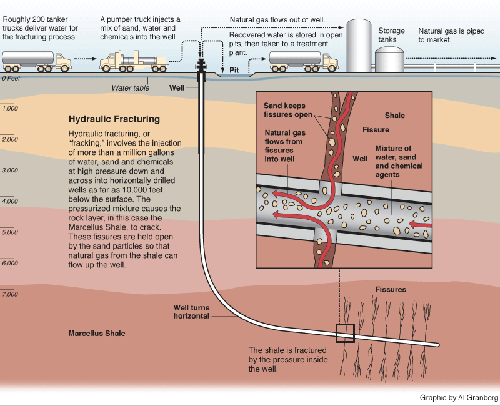What is Fracturing?
Fracturing is a process widely used in well stimulation where millions of gallons of water, sand and chemicals are pumped underground to break apart the rock and release the gas or oil. Hydraulic fracturing is the fracturing of rock by a pressurized liquid. The process is commonly known as fracking, but within the industry the term frac is preferable to frack. However, fracturing would be used rather than fracing.
Induced hydraulic fracturing or hydrofracturing is a technique in which typically water is mixed with sand and chemicals, and the mixture is injected at high pressure into a well bore to create small fractures (typically less than 1mm), along which fluids such as gas, petroleum, uranium-bearing solution, and brine water may migrate to the well. Hydraulic pressure is removed from the well, then small grains of proppant (sand or aluminium oxide) hold these fractures open once the rock achieves equilibrium. The technique is very common in well stimulation for shale gas, tight gas, tight oil, and coal seam gas and hard rock wells. This well stimulation is usually conducted once in the life of the well and greatly enhances fluid removal and well productivity, but there has been an increasing trend towards multiple hydraulic fracturing as production declines.

Fracking process occurs after a well has been drilled and steel pipe (casing) has been inserted in the well bore. The casing is perforated within the target zones that contain oil or gas, so that when the fracturing fluid is injected into the well it flows through the perforations into the target zones. Eventually, the target formation will not be able to absorb the fluid as quickly as it is being injected. At this point, the pressure created causes the formation to crack or fracture. Once the fractures have been created, injection ceases and the fracturing fluids begin to flow back to the surface. Proppants (e.g., usually sand or ceramic beads), which were injected as part of the frac fluid mixture, remain in the target formation to hold open the fractures.
Water and sand make up 98 to 99.5 percent of the fluid used in hydraulic fracturing. In addition, chemical additives are used. The exact formulation varies depending on the well.
Fracturing allows for extended production in older oil and natural gas fields. It also allows for the recovery of oil and natural gas from formations that geologists once believed were impossible to produce, such as tight shale formations in the areas shown on the map below. Hydraulic fracturing is also used to extend the life of older wells in mature oil and gas fields.
Backed by the well equipped infrastructural facilities and experienced personnel, our company has emerged as one of the well established manufacturers and exporters of hydro fracturing unit. These are devised in our state-of-the-art manufacturing unit using high grade raw materials in compliance with international standards. The offered range is highly spoken of by clients due to its long service life, optimum performance and low maintenance features. Our entire assortment is manufactured as per the industrial norms and standards. Offered at industry leading prices, our assortment of hydro fracturing unit is in a high demand in the global market.






 Frac Pumper
Frac Pumper Frac Blender
Frac Blender Data Van
Data Van Hydration Unit
Hydration Unit Sand Truck Unit
Sand Truck Unit Manifold Skid
Manifold Skid Chemical Unit
Chemical Unit Frac Iron Transport Unit
Frac Iron Transport Unit